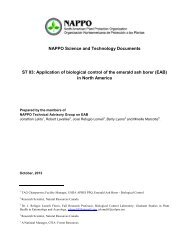NAPPO Regional Standards for Phytosanitary Measures (RSPM)
NAPPO Regional Standards for Phytosanitary Measures (RSPM)
NAPPO Regional Standards for Phytosanitary Measures (RSPM)
You also want an ePaper? Increase the reach of your titles
YUMPU automatically turns print PDFs into web optimized ePapers that Google loves.
continuous effective phytosanitary actions can be applied. The dimensions of the protected areaand the intensity of the phytosanitary procedures will depend on the biology of the pest and theinherent characteristics of the production area.An ALPP can be established <strong>for</strong> tropical, sub-tropical or temperate zone pests across a broadrange of environmental and host conditions. Bilateral workplans using concepts described in thisstandard take into account the variability in pest risk which may be influenced by factors such as:reproductive potential, host range, host distribution, environmental influences on pestestablishment, spread and reproduction, and characteristics of damage caused by immature lifestages that have an impact on pest detection.The low prevalence concept can be applied as follows:• An area temporarily subject to population suppression (to reach the threshold <strong>for</strong> lowprevalence), whose final objective is eradication.• A permanent low prevalence area acting as a buffer zone to protect a Pest Free Area (PFA).• A place of production within a PFA that is under Emergency Action Plan.• A production area (places of production or production sites) permanently under the lowprevalence status where products are exported subject to additional control measures, e.g.,systems approach.Areas of low pest prevalence can be used to facilitate the movement of commodities from areaswhere the target pest(s) is present.A systems approach that includes an area of low pest prevalence can be used by exportingcountries to certify that consignments of plants, plant products and other regulated articlesproduced in and/or moved from that area are free from the target pest(s) and meet therequirements of the importing country. The application of the concept of an area of low pestprevalence will depend on the biology of the pest, the characteristics of the place of production,the operational capabilities of the producer and responsibilities of the National Plant ProtectionOrganization (NPPO).Components of the systems approach include an area of low pest prevalence, trapping, hostsampling, control measures, and/or post-harvest treatments. The system must be sufficient tomitigate the risk of live pest movement to a level equivalent to that of pest free areas. There areseveral existing programs that rely on a systems approach that is designed <strong>for</strong> a specific targetpest and market. Examples include:• Caribbean fruit fly, Anastrepha suspensa, protocol <strong>for</strong> shipment of grapefruit from Florida toJapan;• Mexican fruit fly, Anastrepha ludens, Mexican mango treatment and preclearance program;• Mexican fruit fly protocol <strong>for</strong> shipment of grapefruit from Texas to other U.S. states;• Workplan <strong>for</strong> the exportation of peaches, nectarines, plums and apricots under systemsapproach from the United States to Mexico.<strong>RSPM</strong> No. 20Guidelines <strong>for</strong> the Establishment, Maintenance and Verification of an Area of Low Pest Prevalence <strong>for</strong> Insects Page 7
















